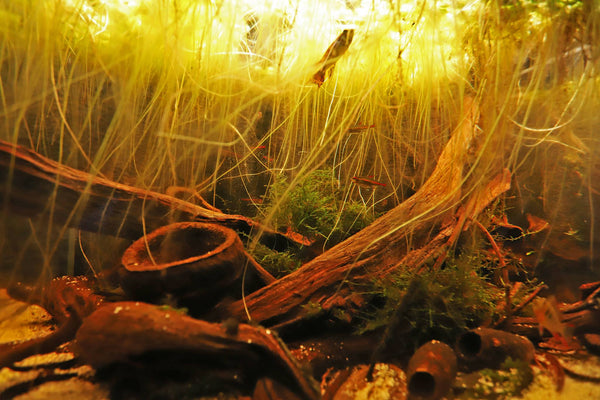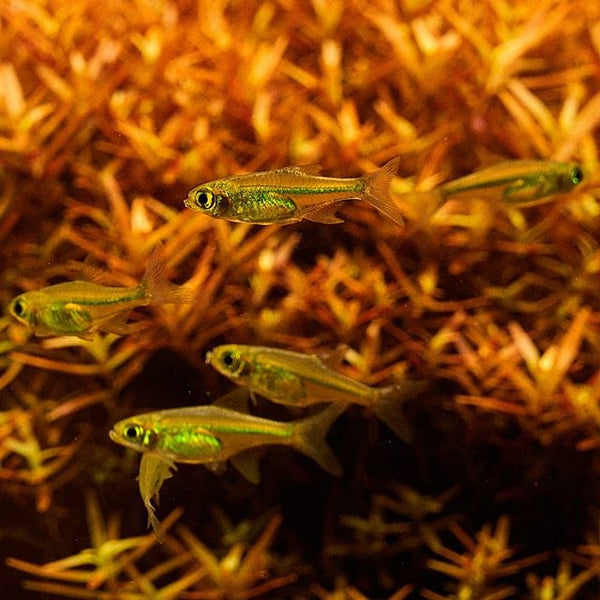- Continue Shopping
- Your Cart is Empty
"You Can't Keep Plants in Blackwater", Right? Maybe? Um...
One of the most common questions and points of discussion we receive and engage in here at Tannin is, "Can you keep aquatic plants in blackwater?"
And of course, the answer is 100%, unequivocally "YES!"

I'll be the first to admit that I am not an expert on aquatic plants by any means, and any discussion on plants which I present is by nature rather superficial and limited. However, I did do a lot of research, read a number of scientific papers, and had some good discussions with those "in the know" about which aquatic plants are commonly associated with these habitats over the years.
The interesting common denominator about this topic- like so many others when it comes to blackwater, is that there is simply a lack of good information and an abundance of speculation, assumption, and downright misinformation floating about out there in cyberland...

I think the misconception that plants can't grow in blackwater partially originates from the common "inflection point" of "Blackwater aquariums are unstable/hard to manage/dark and foreboding", and merges with the well-trodden and partially factual "narrative" that says that, since many parts of say, the Rio Negro essentially have no plants, that plants can't live in any blackwater habitats.

I was able to glean some information that might be of use to you in this regard, and with all of the interest, it seems like an appropriate time to be discussing this stuff!
First, let's just clarify the "plants in Amazonia" thingy real fast.
There are two primary areas of interest in our particular botanical-centric habitat focus, besides just the better-known blackwater rivers, such as the Rio Negro, where plants are found.
The Varzea are seasonally-flooded forest areas, which are inundated by pH-neutral "whitewater" (ie; not significantly stained by tannins), and can reach significant depths, whereas the Igapo are generally shallow, blackwater environments with relatively low nutrient content and acidic soils. Varzea forests are extremely rich, which leads to a very rich aquatic ecosystem when inundated, and tend to have greater density of aquatic plants. Várzea forest soils have high nutrient contents because they receive high loads of sediment (from the Andean and pre-Andean regions) from the whitewater rivers nearby.
Igapó forests, by contrast, do not receive this seasonal influx of sediments , which is why they have relatively inorganic nutrient- poor soils. Igapo waters are acidic, with a pH ranging between 4 and 5, and are rich in organic materials- particularly humic and fulvic acids. It is also thought by scientists that the seasonal inundation of the Igapo soils creates anoxic conditions, limiting plant growth in general.
So, you CAN keep aquatic plants in blackwater aquaria intended to replicate, to some extent, either of these botanically-influenced habitats. Obviously, the Varzea-type flooded forests are more conducive to aquatic plant growth.
And here is the part which probably feeds into the "you can't grow plants in blackwater" myth:
The other important factor affecting plant growth in these aquatic habitats is light; or specifically, light penetration. This affects diversity of both the terrestrial grasses and aquatic plants present in the waters. In the blackwater Igapo areas, light only penetrates down to depths of 1-2 meters, and many submerged grasses and terrestrial forest plants simply die back from lack of light. And the forest canopy adds to the shading in some areas, further reducing the amounts of light available to plants. Varzea tend to be more "open", and a greater abundance of light, and therefore, light penetration, occurs.
Of course, you can grow Amazonian plants in blackwater aquariums, such as the broad-leaved dwarf Amazon sword plant (Echinodorus quadricostatus), which prefers the dim conditions of blackwater rivers. And

Now, there is one area which comes to mind immediately when we talk of blackwater habitats with aquatic plants: Southeast Asia- particularly, Borneo.
And when we think of Borneo, what comes to mind more than the darling of the plant world, Bucephalandra? And of course, my personal fave family of plants, Cryptocoryne. If ever there were "poster children" for blackwater-native/tolerant aquatic plants, either of these two genera would be the ones.

Interesting to me is the use by many hobbyists of low pH substrates and leaf litter in their culture ( a lot of the blackwater Crypt. "players" use Catappa, etc. in a ground up form, almost like a "mulch" of sorts...A cool use for our "Mixed Leaf Media" and "MLM2", I'd say! ). Interestingly enough, many of the so-called "blackwater Crypts" also tend to "melt" if they are in soils that are too nutrient rich...A lot to take in here, but a lot which plays right into our fascination with botanical-style blackwater aquairums!

And what about Africa? It's more than just Anubias...

I think that a considerable amount of time needs to be spent by members of our community simply reaching out to our friends who are into aquatic plants...the knowledge and commonalities are remarkable. We simply need to discuss and understand the realities of keeping plants in blackwater versus the more "traditional" " clearwater" aquarium.
In general, there are a few issues we should consider when it comes to aquatic plants in blackwater aquariums..the primary one being that theme we've touched on before:
It's a known fact that light doesn't penetrate as effectively in the tinted water of blackwater environments. That's ONE of the reasons you don't see a lot of algae in many blackwater systems. And floating plants, of course, tend to do well-because you don't really have the "light penetration factor" influencing them as much as say, rooted plants. Light penetration is a limiting factor, other things being "more-or-less" equal, right?

Well, yeah...you can compensate with brighter light...the beauty of LEDs, right? And of course, just having light in our tanks isn't enough.
The other big issue to tackle when keeping aquatic plants in blackwater aquariums is to some extent, the well-trodden opinion that blackwater may be described as more "nutrient poor", and having much lower ionic concentrations of calcium, magnesium, sodium, and potassium than clearwater environments.

So how do you overcome this?
You fertilize your tank- just like you do in a "clearwater" system. You'll probably have to adjust your doses to compensate for the near lack of the above-referenced major ions, but it's pretty much that simple, in my experience. You'll use more fertilizers. And if you're growing plants that rely on rich substrates, like Cryptocoryne, I've found that you really don't have to do all that much differently than you do in a "clearwater" tank.
One thing you won't hear me talking about is the use of CO2. Not because I don't recommend it or believe in it- it's simply because I don't personally have a lot of experience with using it...That being said, I have many friends who use CO2 in blackwater tanks with a tremendous degree of success...

I think the job I'll continue to take on here at Tannin will be to encourage aquatic plant enthusiasts, and those who want to keep aquatic plants in blackwater aquariums- to go for it and do great work.

The simple reality is that you absolutely can keep a lot of aquatic plants in blackwater tanks, with tremendous success. It's simply a matter of compensating for the environmental parameters which need to be augmented (ie; lighting, fertilization...), and doing what you already know how to do. If you're into environmental/biotopic authenticity, you'd want to look at what plants are found where, of course- but the bottom line is that the variety of plants that you can keep in generic blackwater aquariums is significant!

I think the job I'll continue to take on here at Tannin will be to encourage aquatic plant enthusiasts, and those who want to keep aquatic plants in blackwater aquariums- to go for it and do great work.
The simple reality is that you absolutely can keep a lot of aquatic plants in blackwater tanks, with tremendous success. It's simply a matter of compensating for the environmental parameters which need to be augmented (ie; lighting, fertilization...), and doing what you already know how to do. If you're into environmental/biotopic authenticity, you'd want to look at what plants are found where, of course- but the bottom line is that the variety of plants that you can keep in generic blackwater aquariums is significant!
Ares to explore here include the continued "enrichment" of the substrate and overall aquatic environment with botanical materials, use of varying light intensities, and- once again, CO2.

So...the answer is that you CAN. The challenge is that you SHOULD. The exciting part is that you WILL help dispel the "you can't keep plants in blackwater" myth once and for all...
Stay focused. Stay excited. Stay curious. Stay bold. Stay diligent...
And Stay Wet.
Scott Fellman
Tannin Aquatics
5 Responses
Craig Garza
Hello, would you like grow website traffic, sales & conversions? Start Free Trial, No Upfront – No Contract. Pay Later!
I do Search Engine Optimization Marketing and improve Website Traffic, Website Rankings (Google, Yahoo & Bing), Organic results, SERPs, sales & conversions.
I will get rank your business on the first page of Google & improve Web Presence & Traffic at your Website/Online Store. I have more than 12 years’ experience in Search Engine Optimization Marketing.
Start Free Trial: https://winfytech.com/pro-seo-trial/
Clients Results: https://winfytech.com/revenue-portfolios/
Afi
I keep rotala in my blackwater channa maru tank,and it grows well..the pH is below 6..i use ADA Amazonia soil for the first layer than mix black and red small larva rock..thanks for the info,interesting to see many plants variation can be added to my tank..
AshlynWanderer
I’ve been keeping crypts, rotalas, ferns, wild plants, floaters, monte carlo, and more in a NO tech (except heater and light) blackwater aquarium! it’s dirted but that’s all and the plants are lush and growing.
Scott Fellman
Hey Tomas,
Excited to see you giving a planted blackwater tank a try…SO many cool plants to choose from, and lots of cool stuff to learn! Personally, I use a good quality substrate and if any fertilizers, it would be the “root tab” kinds as opposed to liquids. I’m a pretty big believer in rich substrates above all!
Hope this helps. Good luck!
Regards,
Scott
Tomas
Thanks a lot for this article!
I’m ultimating details to get started in the world of planted tanks, and one of the things that was holding me back the most is the fact that I did not find much information about blackwater plants. Or plants in blackwater. Except for echinodorus, anubias, cryprocorynes and not much else. I’m no going to complain about Cryptos tho, because it was love at first sight lol.
My idea is to start a 24 liter probably unstable nano and if everything goes well, to continue with a 120 liter aquarium. That’s why I was a little worried when I read about an extra fertilization that I hadn’t taken into account. Do you recommend anything in particular for small tanks?
However, I’m still excited and I’m going to continue reading and researching to learn and translate the idea that I have in my head.
Greetings from Argentina!








Scott Fellman
Author